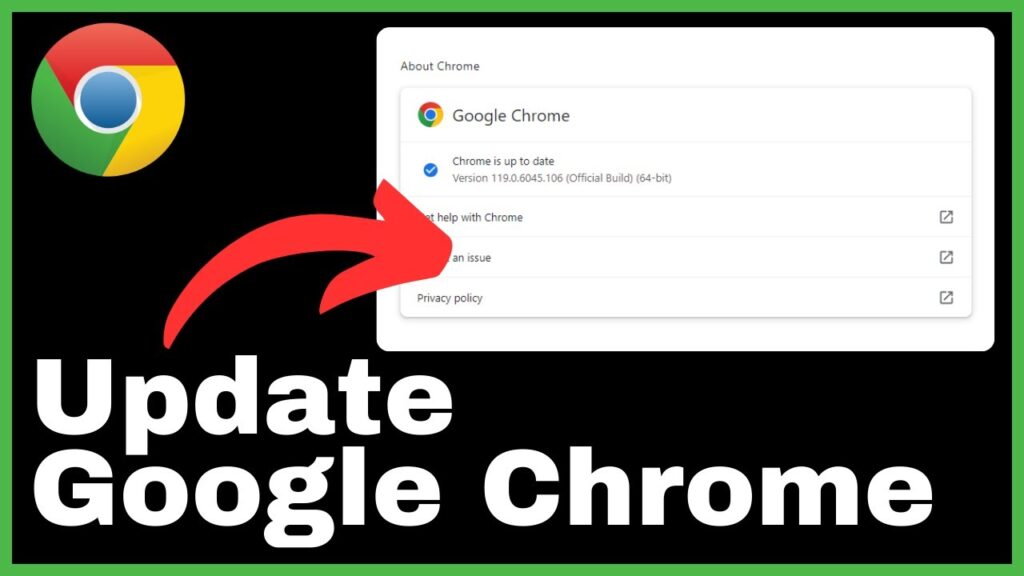In the video titled “How to Update Google Chrome on Windows” by Media Magnet Guide, you will learn the necessary steps to keep your Google Chrome browser up to date on your Windows PC. It is crucial to update your browser regularly to ensure that you have access to the latest features and security enhancements. With this tutorial, you will be guided through the process of updating Google Chrome, allowing you to make the most out of your browsing experience. The video also offers additional tutorials for mastering Google Chrome and provides a platform for viewers to ask questions and make video requests. By following the instructions provided, you can easily update your browser and enable automatic updates for future convenience. Don’t miss out on important updates and stay tuned to Media Magnet Guide for more helpful tech tutorials and resources.

Understanding the Need to Update Google Chrome
Role of Google Chrome updates
Google Chrome regularly releases updates to improve the browsing experience, enhance security, and introduce new features. These updates address bugs, fix vulnerabilities, and optimize performance. Keeping your Google Chrome browser up to date ensures that you have access to the latest features and security enhancements.
Importance of updating Google Chrome on Windows regularly
Updating Google Chrome on your Windows computer is crucial to ensure the best possible browsing experience. New updates often include performance improvements, bug fixes, and new features that enhance your productivity. Additionally, updated versions of Google Chrome often contain security patches that protect against known vulnerabilities, reducing the risk of malware infections and data breaches.
Security enhancements through updates
One of the primary reasons to update Google Chrome is to benefit from the security enhancements provided by updates. The internet landscape is constantly evolving, and cyber threats are becoming more sophisticated. By regularly updating your browser, you can protect yourself against these threats, as updates often include security patches to fix vulnerabilities and strengthen the browser’s defenses. Staying on an outdated version of Google Chrome exposes you to unnecessary risks and makes you more vulnerable to cyber-attacks.
Checking Your Current Google Chrome Version
Locating ‘About Google Chrome’
To check your current Google Chrome version, start by opening Google Chrome on your Windows computer. Look for the three vertical dots in the top-right corner of the browser window. This is the menu option. Click on the dots to open the menu, and then navigate to the Help section.
Interpreting the version number
In the Help section, you will find the “About Google Chrome” option. Click on it to view your current version number. The version number consists of several elements, including major and minor numbers, and potentially a build number or release date. Interpreting the version number requires understanding the versioning system used by Google Chrome.
Determining if an update is needed
To determine if an update is needed, compare your current version number to the latest version available from Google. If your current version is outdated, you need to update Google Chrome to access the latest features and security enhancements. Updating is a straightforward process and can be initiated directly from the browser.
Initiating the Google Chrome Update
Navigating to the update menu
To initiate the update process, start by opening Google Chrome on your Windows computer. Click on the menu option (three vertical dots) in the top-right corner of the browser window. From the menu that appears, navigate to the Help section.
Starting the update process
In the Help section, click on “About Google Chrome.” Chrome will automatically scan for the latest version and begin updating once the checkmark appears, indicating that the update is complete.
Understanding the stages of the update
The update process consists of multiple stages, including downloading the update files and applying the changes to your browser. Some updates may require a browser restart, while others can be applied without a restart. It is essential to follow the prompts and allow the update to complete fully.
Troubleshooting Update Problems
Dealing with failed update attempts
In some cases, the update process may encounter issues and fail to complete successfully. If this happens, there are a few troubleshooting steps you can take. First, ensure that you have a stable internet connection, as a weak or intermittent connection can hinder the update process. You can also try restarting your computer and attempting the update again. If the problem persists, you may need to contact Google Chrome support for further assistance.
Identifying and resolving common update errors
Common update errors can include network errors, insufficient disk space, or conflicts with other software on your computer. To identify and resolve these errors, you can check the error message displayed during the update process. Google Chrome’s support documentation provides detailed instructions for troubleshooting specific error codes or messages.
When to contact Google Chrome support
If you have exhausted the troubleshooting steps and are still unable to update Google Chrome successfully, it may be necessary to contact Google Chrome support for expert assistance. They can provide guidance tailored to your specific issue and help you resolve any complications preventing the update process.
Monitoring the Update Process
Observing the update progress
During the update process, it is essential to monitor the progress to ensure that it completes successfully. The update progress may be displayed within the browser, typically in the form of a progress bar or a percentage indicator. Keep an eye on this indicator to track the update’s progress.
Interpreting the update status
Once the update completes, you will see a checkmark or a message indicating a successful update. This confirms that you are now using the latest version of Google Chrome.
Confirming successful updates
To verify that the update was successful, you can revisit the “About Google Chrome” section. Check the version number to ensure that it matches the latest version available from Google. If the version number has been updated, it confirms that the update was successful.
Relaunching Google Chrome
How to relaunch Google Chrome
After an update, you may need to relaunch Google Chrome to apply the changes fully. To do this, click on the “Relaunch” option if it is displayed within the browser. If the option is not available, you can manually restart Google Chrome by closing the browser and reopening it.
What happens to your tabs and windows
When you relaunch Google Chrome after an update, your tabs and windows should be restored automatically. Chrome’s built-in functionality preserves your browsing session, ensuring that you can continue where you left off.
Resolving relaunching issues
If you experience any issues during the relaunch process, such as missing tabs or windows, try restarting your computer and relaunching Google Chrome again. If the problem persists, it may be necessary to reinstall Google Chrome to resolve any underlying issues.
Verifying the Updated Google Chrome Version
Checking the updated version number
To verify that Google Chrome has been successfully updated, open the browser and navigate to the “About Google Chrome” section as explained earlier. Check the version number displayed to ensure that it matches the latest version available from Google.
Understanding the changes in the updated version
By checking the release notes provided by Google Chrome, you can gain insights into the changes introduced in the updated version. These changes may include new features, bug fixes, performance enhancements, and security updates.
Dealing with post-update issues
In some cases, an update may introduce unforeseen issues or conflicts with specific websites or extensions. If you encounter any post-update issues, you can try clearing your browser cache, disabling extensions, or resetting Chrome settings to their default values. If the problem persists, consult Google Chrome’s support documentation for further guidance.
Understanding Automatic Google Chrome Updates
Benefits of automatic updates
Enabling automatic updates allows Google Chrome to update itself seamlessly in the background. This ensures that you are always using the latest version without requiring manual intervention. Automatic updates provide continuous access to new features, performance improvements, and security updates, reducing the risk of vulnerabilities and ensuring a smooth browsing experience.
Setting up automatic updates
To enable automatic updates, navigate to the automatic updates menu within Google Chrome’s settings. Follow the prompts to configure the automatic update settings according to your preferences. Once enabled, Google Chrome will regularly check for updates and apply them automatically.
Ensuring automatic updates are working properly
After enabling automatic updates, it is crucial to ensure that they are working correctly. Periodically check the update status within the browser or revisit the “About Google Chrome” section to verify that updates have been applied. If automatic updates fail to work as expected, consult Google Chrome’s support documentation or contact their support team for assistance.
Reinstalling Google Chrome
When to consider reinstalling
There are instances when reinstalling Google Chrome becomes necessary. If you encounter persistent issues with Google Chrome, such as frequent crashes or unresolvable errors, reinstalling can help resolve these problems. Reinstalling is also beneficial if you are using an outdated version that does not support the automatic update process.
Detailed process of reinstalling Google Chrome
To reinstall Google Chrome, start by downloading the latest version from Google’s official website. Launch the installer file, and follow the on-screen prompts to uninstall the existing version and install the new one. Once the installation is complete, open Google Chrome to begin using the latest version.
Resolving issues during the reinstallation process
During the reinstallation process, you may encounter issues such as incomplete installations or conflicts with other software on your computer. To resolve these issues, ensure that you have administrative privileges, temporarily disable any conflicting software, and follow the installation prompts carefully. If problems persist, consult Google Chrome’s support documentation or contact their support team for assistance.
Conclusion
Key takeaways about updating Google Chrome on Windows
Updating Google Chrome on your Windows computer is crucial for a secure and up-to-date browsing experience. Regular updates provide bug fixes, performance enhancements, and security patches that protect against cyber threats. It is essential to periodically check your current version, initiate updates when necessary, and ensure that automatic updates are enabled for ongoing protection.
Handling future Google Chrome updates
With the knowledge gained from this article, you can confidently handle future Google Chrome updates on your Windows computer. Remember to regularly check for updates, understand the update process, and troubleshoot any potential issues that may arise.
Keeping track of Google Chrome update news
To stay informed about the latest Google Chrome updates, it is recommended to visit Google’s official website or follow their official blog and social media channels. These platforms provide news and announcements regarding upcoming features, security updates, and other relevant information to help you stay ahead in the ever-changing landscape of web browsing.


























